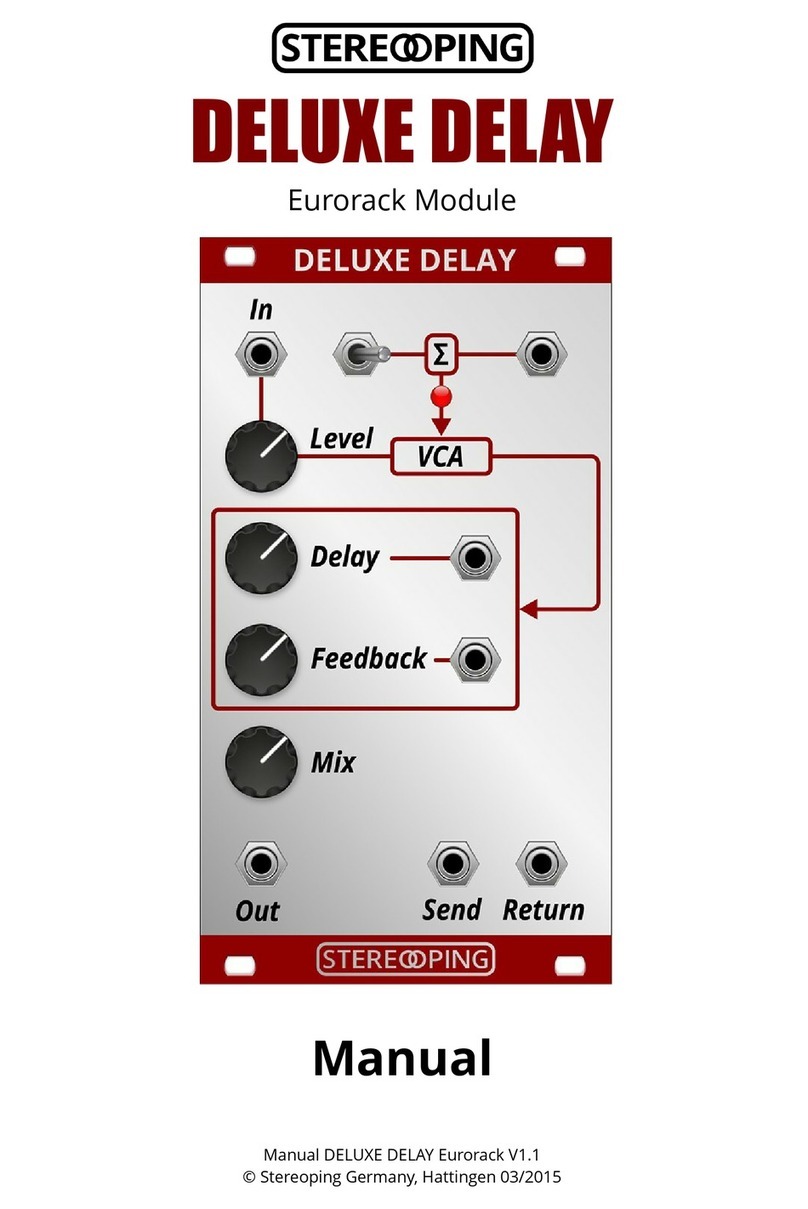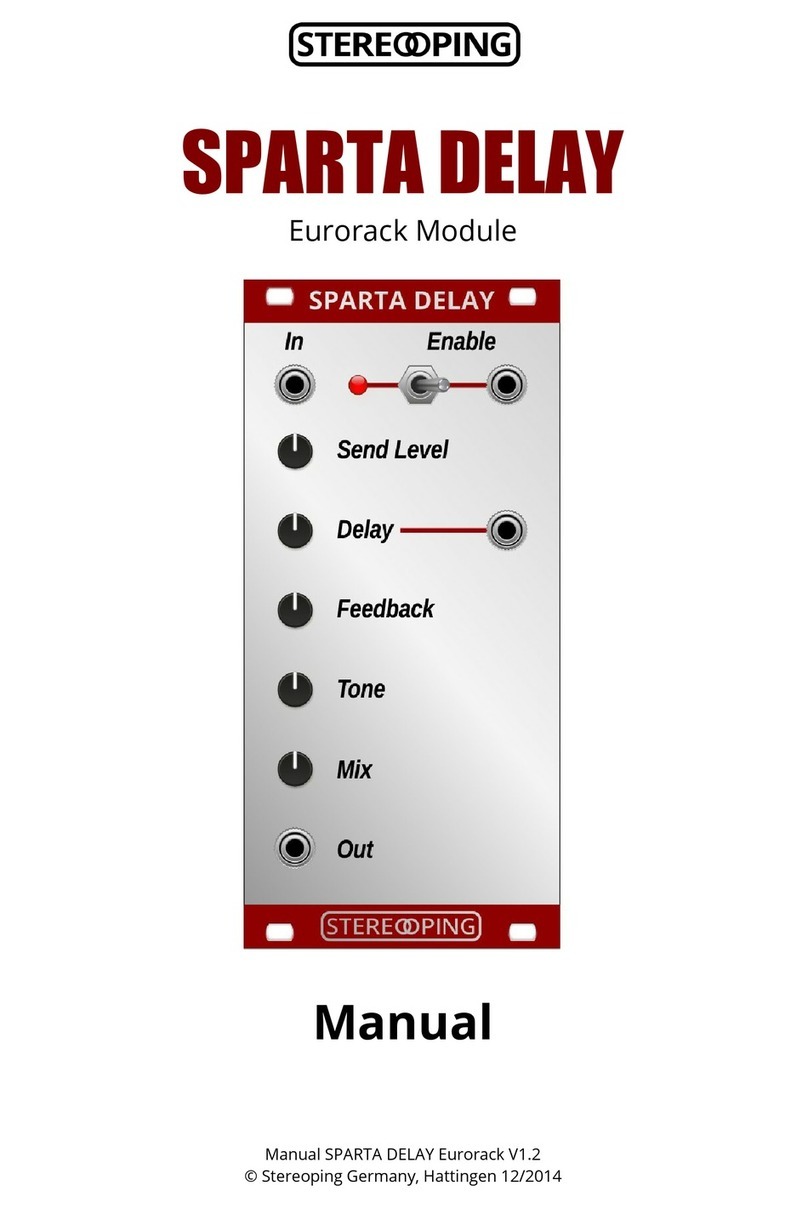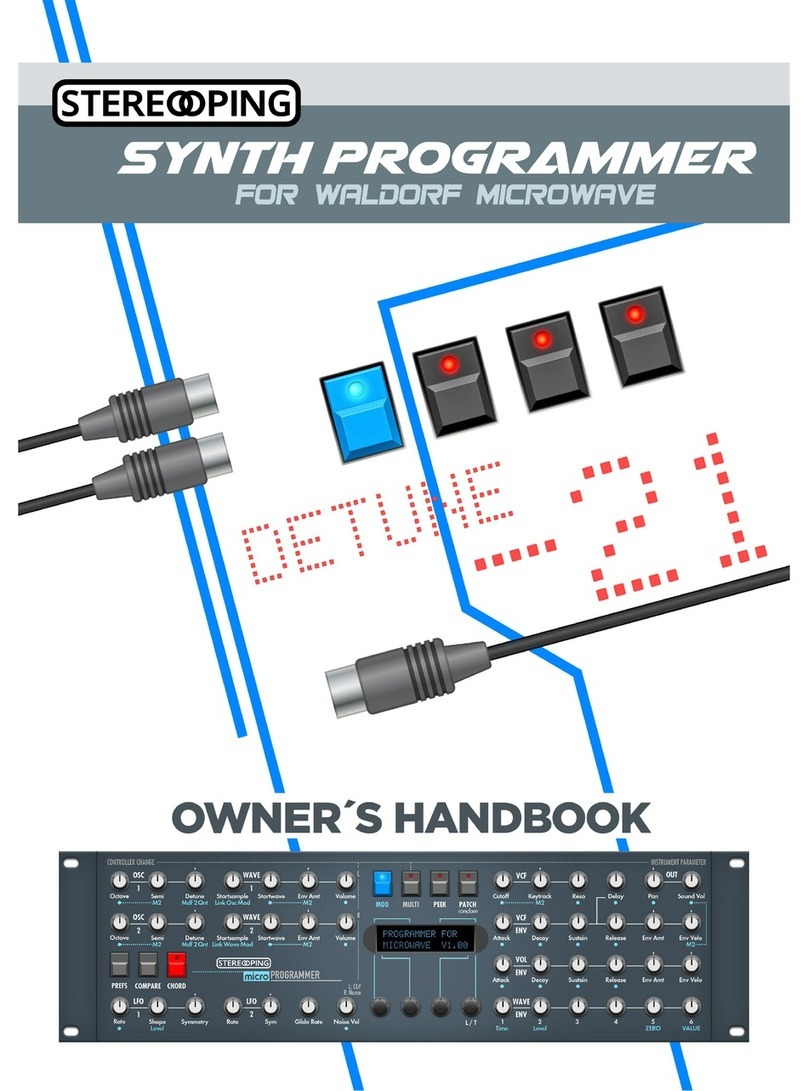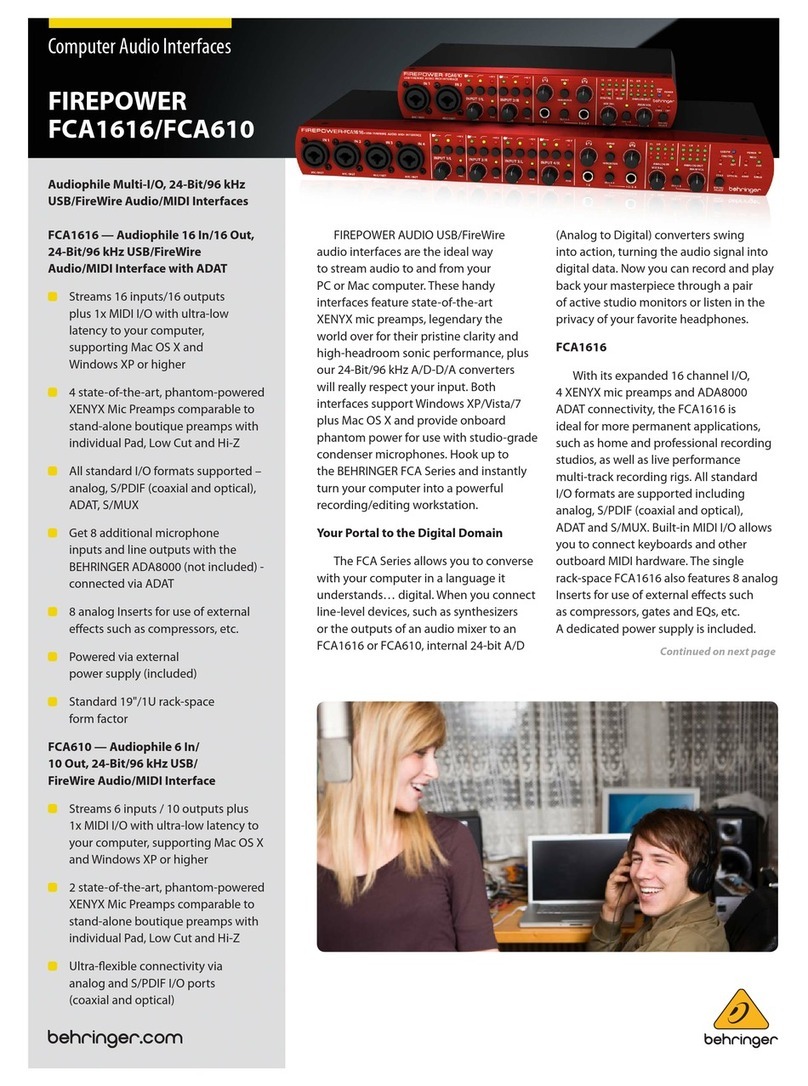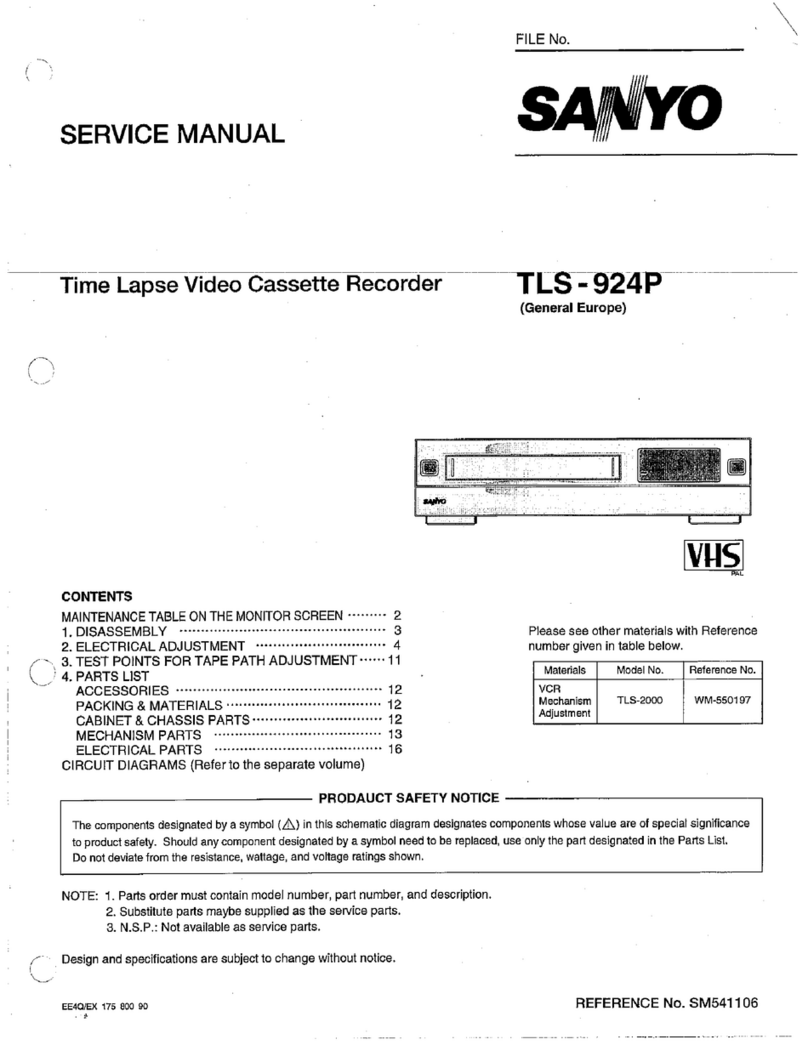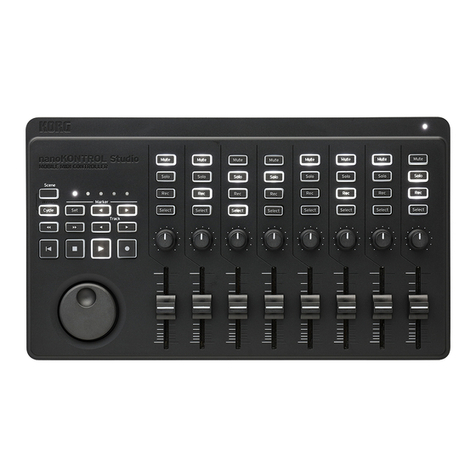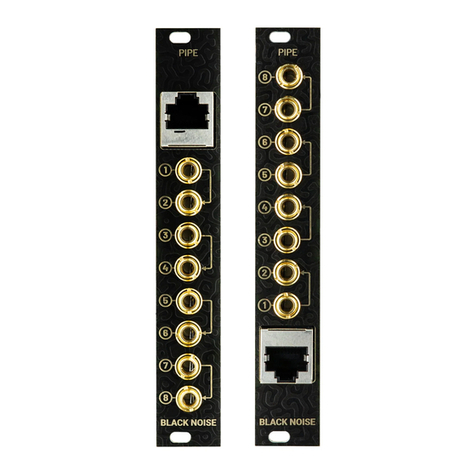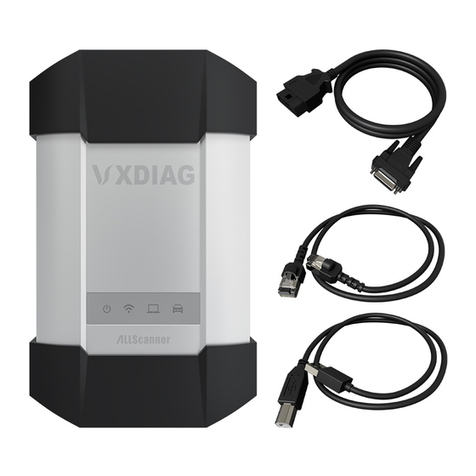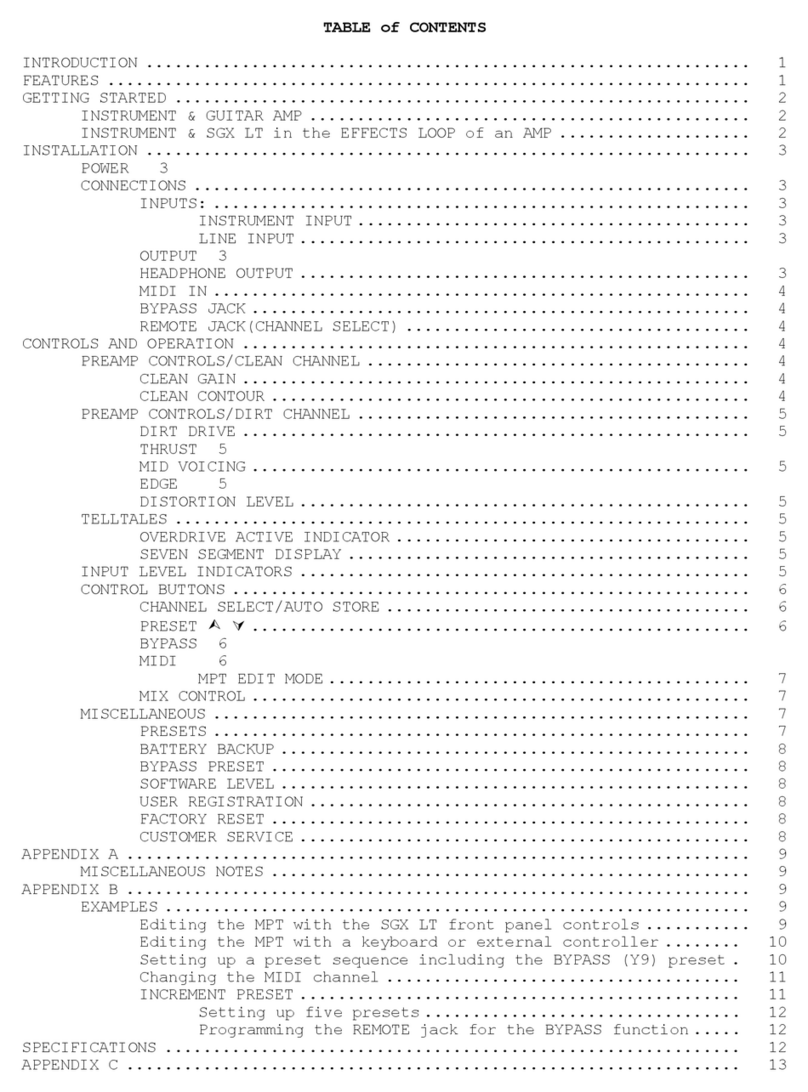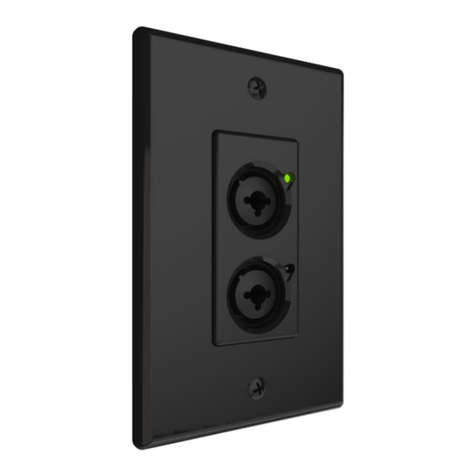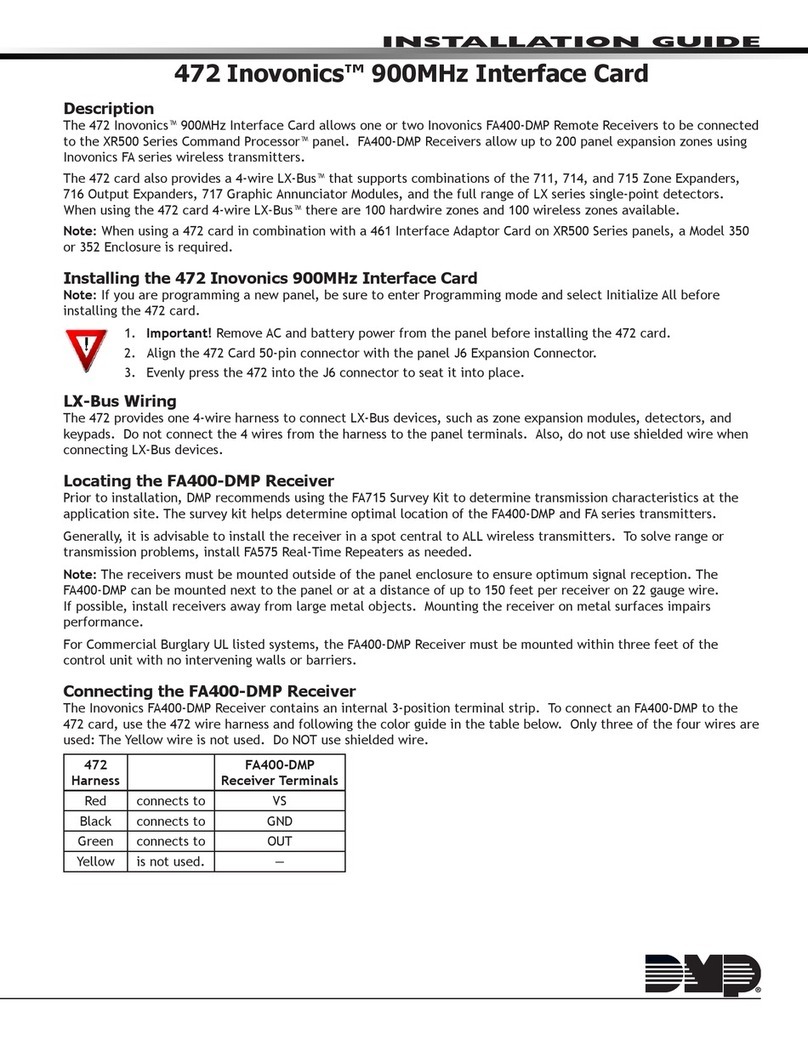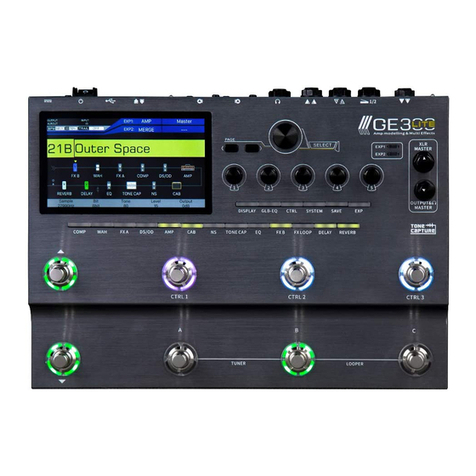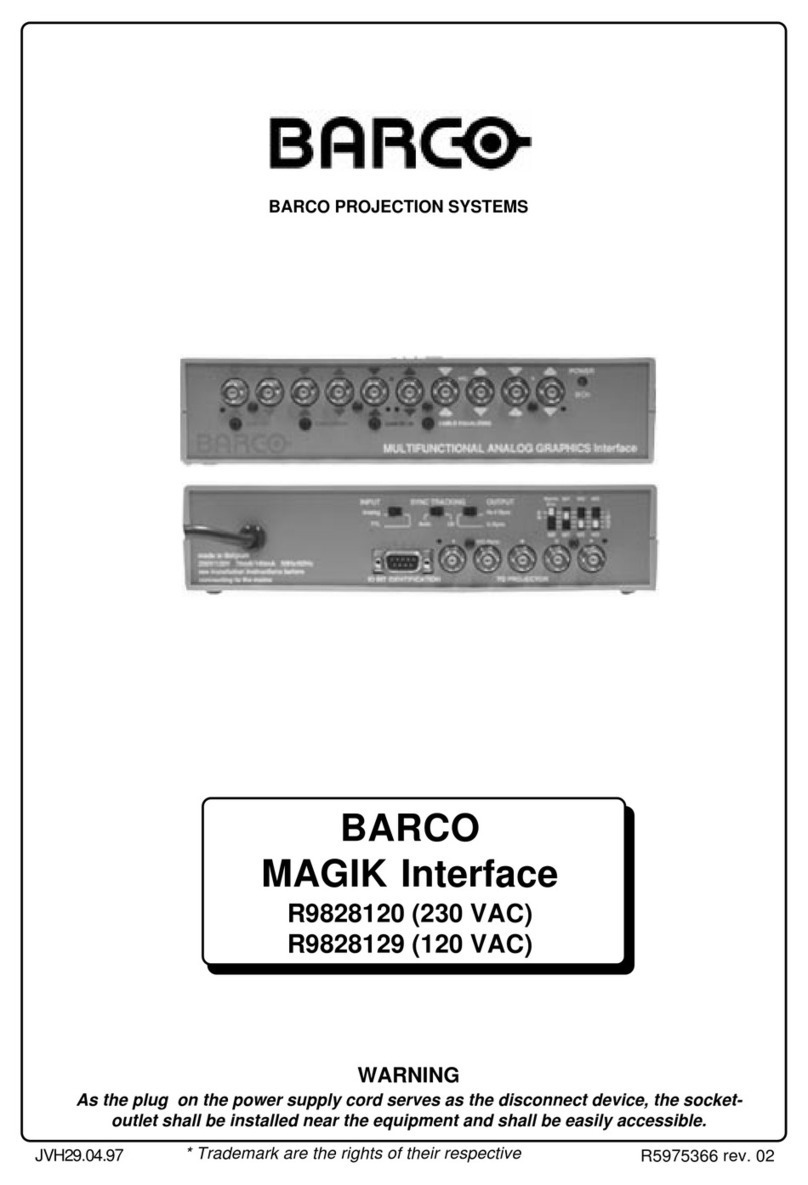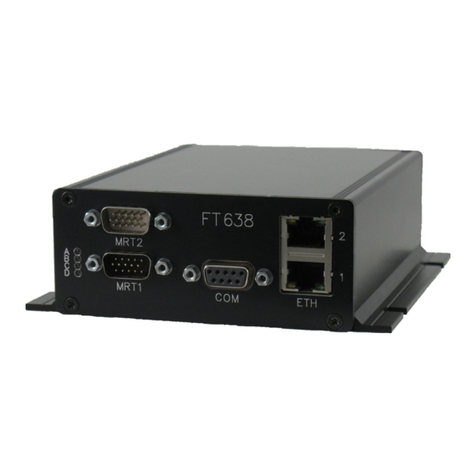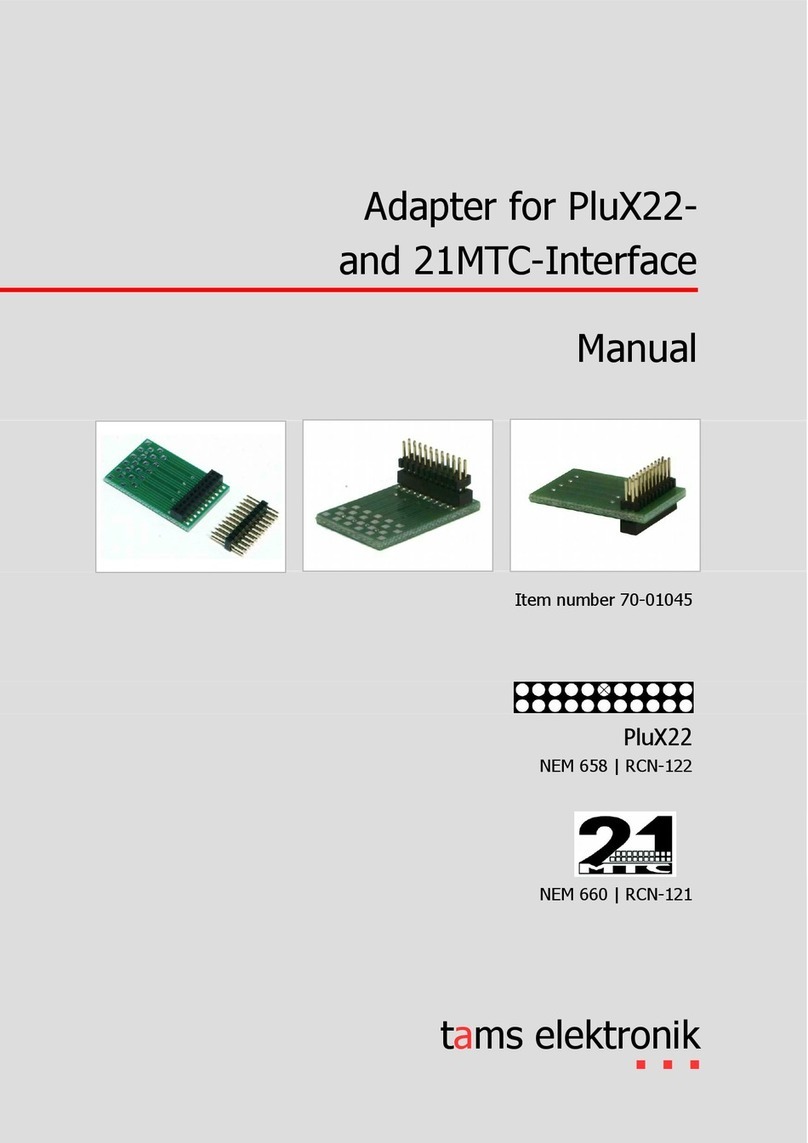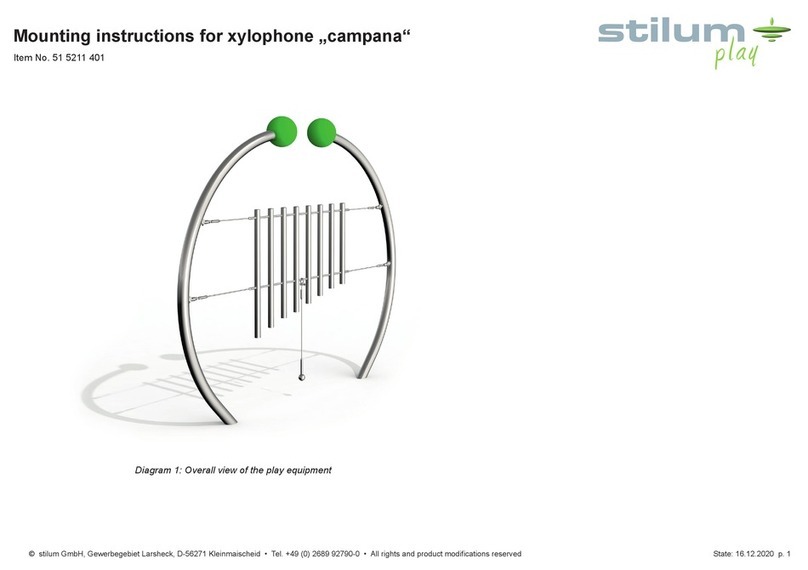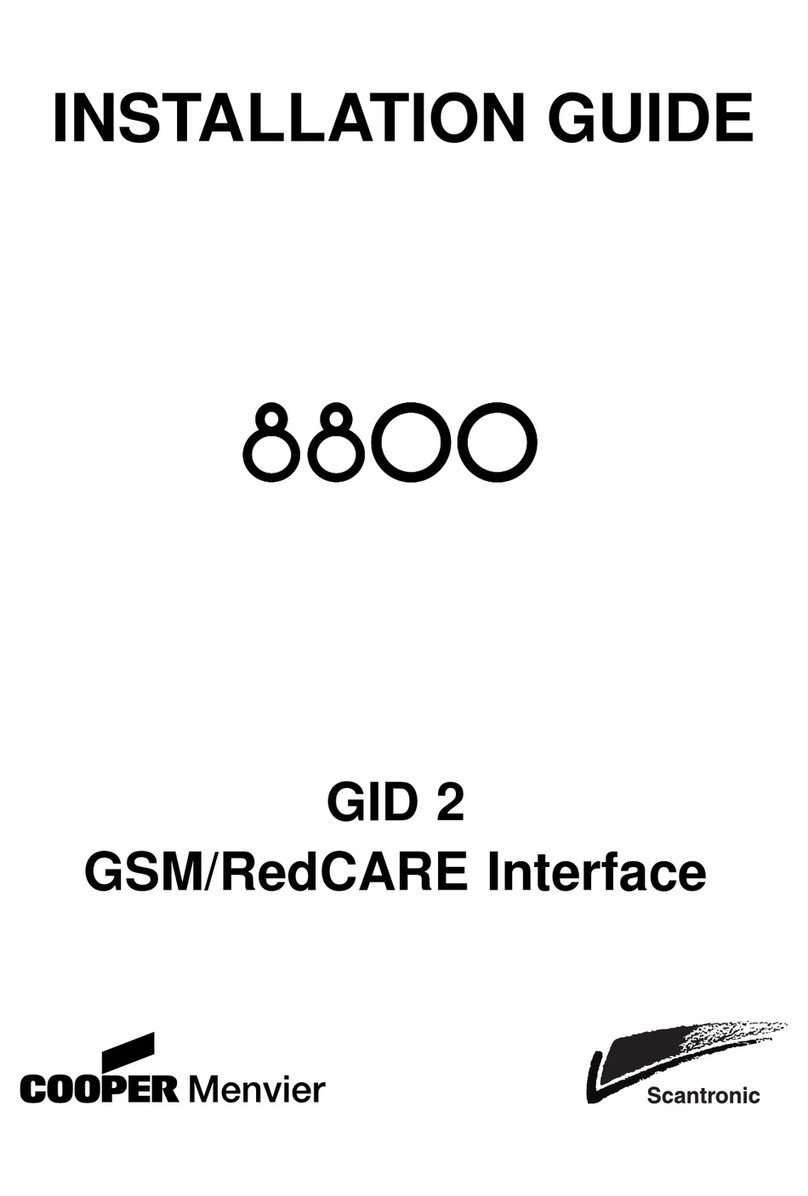Stereoping SPRING REVERB User manual

SPRING REVERB
Eurorack Module
Manual
Manual SPRING REVERB Eurorack V1.3
© Stereoping Germany Hattingen 03/2015

Main features SPRING REVERB
•Eurorack module to work with almost any reverb-tank no matter if insulated or
grounded or whatever impedance
•„Send Level“ allows intended overdriving the tank's input coil over a wide range
(clean up to heavy distortion)
•Active 4-band equalizer for creative soundshaping of the pure reverb signal
•„Current“ trimpot further alters the sound characteristics of the tank
•„Mix“ knob from 100% dry to 100 % wet - suitable for insert-usage
•Width 60 6 mm / 12 TE Depth about 25 mm
•Current draw: +12 V - 23 mA -12 V - 23 mA
Functional block diagram
Manual SPRING REVERB Eurorack V1.3
© Stereoping Germany Hattingen 03/2015

The S ring Reverb tank
The SPRING REVERB module itself can not produce any reverb. It delivers just the
electronics to drive an external reverb tank and heavily amplifies the tanks weak
output up to line levels. For desired operation you need to attach a reverb tank to it.
This tank was either delivered with your module or you ordered the module to breath
new life in an old tank you still had lying around somewhere.
„What tank do i need and which sound best?“
For the development of the SPRING REVERB module we collected about 30 different
tanks with vastly varying Input-/Output impedances 1 2 or 3 springs short or long
housing brandnew ones and originals from the past Input-/output-jacks insulated or
grounded … the result in short:
•until now EVERY tank worked right away together with the SPRING REVERB
module – no matter which impedance or grounding of the input-/output-jacks
•tanks with middle high impedanz (e.g. 4BB...) seam to be the best in
combination with the module the EQ gets the most out of them. Larger
impedances (e.g. 8EB...) also work well. Very small impedances (e.r. 4AB...) seem
to have a low level and sound a bit flat
•a good tank with 2 springs can have a better sound with more density than a
bad tank with 3 springs
•large tanks with long springs (with a „4“ at the beginning) must not
automatically sound better or have a longer decay than short tanks (beginning
with an „8“)
•the whole quality of the spring reverb sound depends on the quality of your
tank and it's springs and is – a matter of luck. We got e.g. an old Accutronics
which sounds marvelous. A new rebuild with exactly the same technical data
connected to the same module sounds significantly worse and 'cheaper'.
•Each tank sounds different and has different characteristics like density of the
reverb frequency range sensibility to concussion reverb length – all in all it's a
matter of personal taste. Some like a dense and natural short reverb others
prefer the dirty oil tank sound with long reverb.
On our website we have some more information about reverb tanks and many sound
examples.
Manual SPRING REVERB Eurorack V1.3
© Stereoping Germany Hattingen 03/2015

Connecting to a tank
The majority of reverb-tanks interface to the
outer world by cinch-jacks. This is why we
have also chosen cinch-jacks to connect this
module with your tank. You will need a
simple cinch-to-cinch stereo audio cable to
connect both.
Near the golden connectors you will see two
words on the pcb "Send" and "Return".
The Send-jack has to be connected with
the tanks "In"-connector. Of course the
Return-rail connects to the tanks output.
That's it. If you should be chance mistake the
inputs and outputs and connect your tank
the wrong way . Don't worry. Nothing bad will happen. It might even come out your
tank sounds even better :-)
Now you have to place your tank somewhere. The tank's levels of operation are very
small therefore it is not uncommon to catch unwanted hum or noises with the tank
the cable or even the module itself. The bad noises are coming most probably from
your power supply's transformer. Try to position module and tank with some distance
to the Power supply. If it does not help try a longer cable (e.g. 2 meters) and place the
tank even outside of your cabinet.
Manual SPRING REVERB Eurorack V1.3
© Stereoping Germany Hattingen 03/2015

Connecting to ower
Interfacing power is the same as for any other
module for eurorack. The pic to the right shows
the typical eurorack power bus pins.
!! Please ay double attention to ut the
connector cable in the right direction on the
module itself and the owerbus connector.
Attaching the cable in the wrong way could
lead to damage onto the module or even your
ower su ly !!
Put the powercord onto the power connector
with the red wire pointing towards the lower
edge of the module.
Like in the picture to the right.
The red wire indicates the -12 Volt rail.
The other connector of the cable must be
plugged onto your module systems power-bus.
Again with the red wire pointing down.
Manual SPRING REVERB Eurorack V1.3
© Stereoping Germany Hattingen 03/2015

Interface
"In" jack
This is the typical 3.5 mm mono jack where to
put the typical audio signal from your mixer
an oscillator of your module system or a
synth-output.
"Current" trimmer
This little trimpot won't be changed too often
in daily use of the module. It's function is to
limit the current going into the input coil of
the tank. This affects the characteristics of the
sound more than the level itself. The results
can be more or less dramatic according to the
characteristics of your tank. Adjust this
trimpot to your personal taste. The more you
turn it to the right the brighter more jarring
and distorted your tank will sound.
"Send Level" knob
Here you can adjust the voltage amplification
of the amp driving your tanks input coil. This
knob determines the saturation or - in higher
positions - the distortion of your tank's input
coil and therefore is in fact fundamental for
the overall 'sound' of the reverb.
Caution! A highly cranked „Send Level“ can
lead to much higher reverb-levels than your
input signal is. If you start with getting to know the module and your tank – begin your
reverb sessions with low „Send Level“ and the knob turned more to the left.
The fullmost left position turns the send level down to zero resulting in NO reverb at
all even if you turn up „Mix“.
Manual SPRING REVERB Eurorack V1.3
© Stereoping Germany Hattingen 03/2015

"Reverb E " knobs
The 4 knobs "High" "High Mid" "Low Mid" and
"Low" allow the 15db dampening or
amplification for 4 frequency bands in the
reverb signal which is in fact an equalizer. The
frequencies are around
•80-240 Hz
•240-1.000 Hz
•1.000-3.000 Hz
•2.800-12.000 Hz
The EQ is located after the recovery amp and
works on the pure reverb signal. Tweaking the
EQ allows lots of interesting tones especially
in tandem with the „Send Level“-pot.
"Mix" knob
Easy: this adjusts the ratio between 100% dry
input signal in leftmost position and - you
guess it - 100% reverb sound in the fully
clockwize position.
The level of the pure reverbsignal might be
quite high depending on the position of "Send
Level". Use "Mix" to compensate this by
turning it more towards "Dry".
The electronic circuit causes the dry output
signal to be inverted (180°) to the original input signal.
"Out" jack
Here you get the output of the module - the mix of dry and wet signal - according to
the position of "Mix".
Now you're equi ed with all you need to know. Have fun ex erimenting and
meeting the Stereo ing S ring Reverb.
Manual SPRING REVERB Eurorack V1.3
© Stereoping Germany Hattingen 03/2015

Im rint
If you experience any problems using this product are coming up with a genious
improvement feature if you are missing something or just want to write us that you
LOVE our product go ahead. We are looking forward to receiving your Mail!
hello@stereo ing.com
Adress Stereoping
Gregor Zoll Musikelektronik
Waldstrasse 52
45525 Hattingen
Germany
E-Mail hello@stereoping.com
Homepage http://www.stereoping.com
Manual SPRING REVERB Eurorack V1.3
© Stereoping Germany Hattingen 03/2015
Other manuals for SPRING REVERB
1
Table of contents
Other Stereoping Recording Equipment manuals

